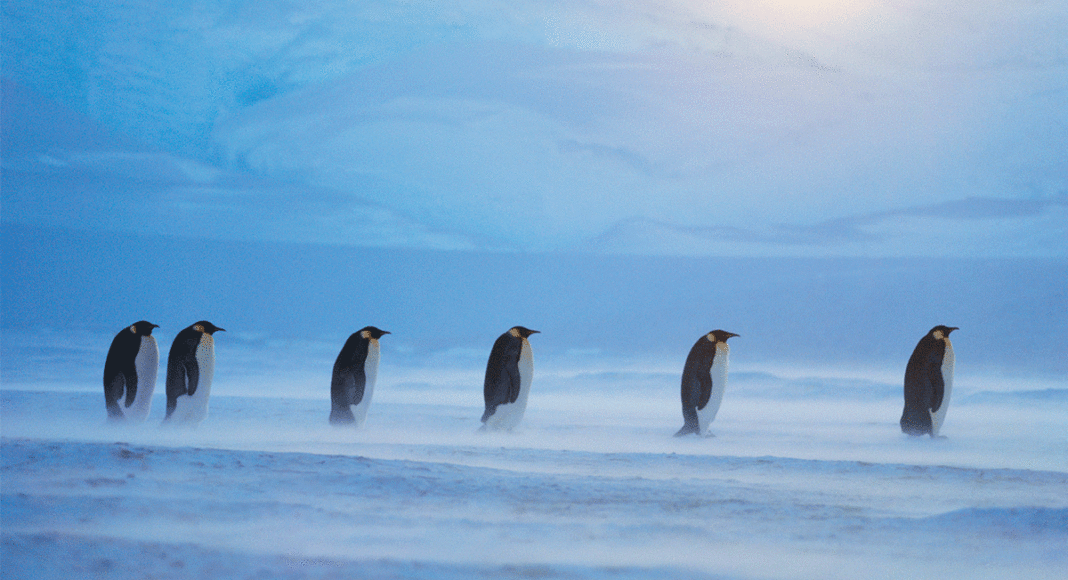The next time you take a photo with your iPhone, Frans Lanting hopes you’ll think about Frank Hurley, the Australian photographer who documented explorer Ernest Shackleton’s legendary Imperial Trans-Antarctic Expedition from 1914 to 1916. Shackleton’s story is outrageous—in his failed attempt to make the first land crossing of the Antarctic continent, he made a treacherous 800-mile open-boat journey after his ship Endurance was frozen and crushed in the ice, eventually saving every one of the more than two dozen members of his crew. But Hurley’s far lesser-known story is, for a student of photographic history, nearly as fascinating. After the ship sank, he had only one camera and four rolls of film left to work with. Yet without the images he captured, Shackleton’s feat would have never captured the public’s imagination in the same way. The Kodak folding camera and roll film that he used were the state of the art at the time.
“It was really the camera that made photography mobile 100 years ago,” says Lanting. “Before that time, photography was done with big heavy wooden cameras with glass plates, cameras mounted on heavy tripods. It was all very static. These Kodak cameras with the roll film made it mobile and it created a photography revolution that was comparable to what the iPhone did 100 years later.”
What Lanting hopes you won’t think about, however, is actually trying to use one of the cameras from Hurley’s era. He did, when he and his wife Chris Eckstrom traveled to the Antarctic last year. In honor of the centennial of the expedition’s safe return, and because he has long idolized Hurley, Lanting took along the exact type of camera that Hurley used, and even recreated some of the photos that he took on the ill-fated expedition. By the end, he was cured of several of his romantic notions about early photographic technology.
“It was really hard,” says Lanting. “It was a very humbling experience. You have very few controls, there’s only two shutter speeds and two apertures, and almost no control over your focus. Everything is laborious. It only increased my appreciation and admiration for Frank Hurley and what he was able to do under conditions that were far more adverse than what I was facing.”
On Feb. 11 at the Rio Theatre, Lanting and Eckstrom will share images and stories from those most recent Antarctic adventures in a program titled “Journeys to the Ends of the Earth.”
As with all of the Dutch-born, internationally renowned photographer’s presentations, there is more going on thematically than just a parade of stunning nature shots.
“I think the Antarctic has a particular resonance with people, because it has that mystique of the most remote, the most extreme place on Earth,” he says. “But it also has a real relevance for all of us now, because it’s becoming one of the epicenters for climate change. That was another thing that we were confronted with during our time down there. We’d been there quite a few times before, and even though I’m not a scientist, you could just see the changes. The glacial retreat is really rapid, and it’s causing changes in the wildlife, in the penguin colonies. Places where I remember going ashore and setting foot on snow and ice, now you’re setting foot on naked rock. The changes are happening very quickly.”
Lanting and Eckstrom’s aim in this show is not to frighten people with the reality of what is happening, but inspire them. To that end, they’ll discuss what they call “hope spots” in not only the Antarctic, but also Patagonia, the Falkland Islands, and the island of South Georgia.
“Since Nov. 8, we live in a different country, and we’re facing a different world,” says Lanting. “We think it’s really important to show people that what happens in Washington D.C. is not the only way that we can make progress on things we believe in.”
In Patagonia, for example, the late Douglas Tompkins, co-founder of the North Face company, and his widow, Kristine McDivitt Tompkins, invested more than $375 million in turning land into protected national parks. While the Tompkins’ immense wealth made their projects possible, Lanting contrasts it with the work that sheep farmers in the Falkland Islands are doing to protect wildlife there.
“It’s not just wealthy individuals who can make a difference, it’s people from all walks of life,” says Lanting. He hopes that these “case studies” leave the audience feeling energized, “because we all have work to do in the next couple of years, instead of giving in to cynicism or fear.”
‘Journey to the Ends of the Earth’ will be presented at 3 p.m. and 7 p.m. on Saturday, Feb. 11 at the Rio Theatre in Santa Cruz Tickets are $23 general, $40 gold circle, available at brownpapertickets.com.













